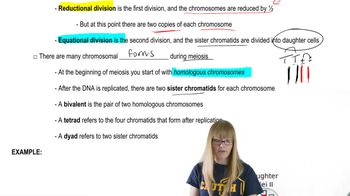Here are the essential concepts you must grasp in order to answer the question correctly.
Synaptonemal Complex
The synaptonemal complex is a protein structure that forms between homologous chromosomes during meiosis. It facilitates the pairing and alignment of homologs, ensuring accurate segregation during cell division. This complex is crucial for genetic recombination, as it allows for the exchange of genetic material between homologous chromosomes, contributing to genetic diversity.
Recommended video:
Meiosis
Meiosis is a specialized type of cell division that reduces the chromosome number by half, resulting in four haploid cells from one diploid cell. It consists of two sequential divisions: meiosis I and meiosis II. This process is essential for sexual reproduction, as it produces gametes (sperm and eggs) that carry half the genetic information necessary for the formation of a new organism.
Recommended video:
Homologous Chromosomes
Homologous chromosomes are pairs of chromosomes, one inherited from each parent, that have the same genes at the same loci but may carry different alleles. During meiosis, these chromosomes undergo pairing and recombination, which is facilitated by the synaptonemal complex. This pairing is vital for ensuring that each gamete receives one chromosome from each homologous pair, maintaining genetic stability across generations.
Recommended video:
 Verified step by step guidance
Verified step by step guidance Verified video answer for a similar problem:
Verified video answer for a similar problem:

